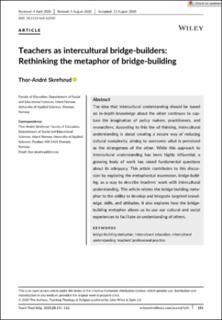| dc.contributor.author | Skrefsrud, Thor-André | |
| dc.date.accessioned | 2021-03-11T15:09:17Z | |
| dc.date.available | 2021-03-11T15:09:17Z | |
| dc.date.created | 2020-09-03T11:23:36Z | |
| dc.date.issued | 2020 | |
| dc.identifier.citation | Teaching Theology and Religion. 2020, 23 (3), 151-162. | en_US |
| dc.identifier.issn | 1368-4868 | |
| dc.identifier.uri | https://hdl.handle.net/11250/2732976 | |
| dc.description | © 2020 The Authors. Teaching Theology & Religion published by John Wiley & Sons Ltd. | en_US |
| dc.description.abstract | The idea that intercultural understanding should be based on in‐depth knowledge about the other continues to capture the imagination of policy makers, practitioners, and researchers. According to this line of thinking, intercultural understanding is about creating a secure way of reducing cultural complexity, aiming to overcome what is perceived as the strangeness of the other. While this approach to intercultural understanding has been highly influential, a growing body of work has raised fundamental questions about its adequacy. This article contributes to this discussion by exploring the metaphorical expression, bridge‐building, as a way to describe teachers' work with intercultural understanding. The article relates the bridge‐building metaphor to the ability to develop and integrate targeted knowledge, skills, and attitudes. It also explores how the bridge‐building metaphor allows us to use our cultural and social experiences to facilitate an understanding of others. | en_US |
| dc.language.iso | eng | en_US |
| dc.rights | Navngivelse 4.0 Internasjonal | * |
| dc.rights.uri | http://creativecommons.org/licenses/by/4.0/deed.no | * |
| dc.subject | bridge-building metaphor | en_US |
| dc.subject | intercultural education | en_US |
| dc.subject | intercultural understanding | en_US |
| dc.subject | teachers' professional practice | en_US |
| dc.title | Teachers as intercultural bridge‐builders: Rethinking the metaphor of bridge‐building | en_US |
| dc.type | Peer reviewed | en_US |
| dc.type | Journal article | en_US |
| dc.description.version | publishedVersion | en_US |
| dc.source.pagenumber | 151-162 | en_US |
| dc.source.volume | 23 | en_US |
| dc.source.journal | Teaching Theology and Religion | en_US |
| dc.source.issue | 3 | en_US |
| dc.identifier.doi | 10.1111/teth.12550 | |
| dc.identifier.cristin | 1827018 | |
| cristin.ispublished | true | |
| cristin.fulltext | original | |
| cristin.qualitycode | 1 | |

